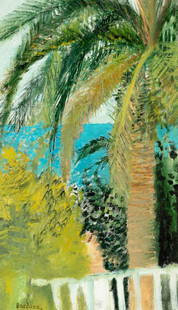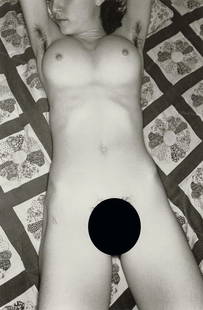
AUGUSTE RODIN (French, 1840-1917) Le Baiser, 3èm
Auguste Rodin Sale History
View Price Results for Auguste RodinRelated Paintings
More Items from Auguste Rodin
View MoreRecommended Art
View More



Item Details
Description
Le Baiser, 3ème réduction, designed in 1886, the reduced version conceived in 1901, and this cast executed between 1905 and1910
Bronze with brown patina
15-3/4 x 9-3/4 x 10-1/2 inches (40.0 x 24.8 x 26.7 cm)
F. Barbedienne ed.
Signed on front of rock to the right: Rodin
Inscribed along edge of base on left side of rock: F. BARBEDIENNE Fondeur Stamped on inside of base: P / P and VL
PROVENANCE:
Collection of M.H.W. Ritchie, Amarillo, Texas;
By descent to the present owner.
LITERATURE:
G. Grappe, Le Musée Rodin, Monaco, 1947, p. 142 (une version en marbre illustrée, pl. 71).
C. Goldscheider, Rodin, sa vie, son oeuvre, son héritage, Paris, 1962 (une version en marbre illustrée, p.49).
A.E. Elsen, Rodin, New York, 1963, p. 218 (une autre épreuve illustrée, p. 63).
I. Jianou et C. Goldscheider, Rodin, Paris, 1967, p. 102 (une version en marbre illustrée, pl. 54-55).
R. Descharnes et J.-F. Chabrun, Auguste Rodin, Lausanne, 1967, p. 130 (une version en marbre illustrée, p. 131).
C. Goldscheider, Rodin Sculptures, Londres, 1970, no. 49 (une version en marbre illustrée).
J.L. Tancock, The Sculpture of Auguste Rodin, Philadelphie, 1976, pp. 72, 77, 90 et 108 (une version en marbre illustrée, p. 77).
M. Laurent, Rodin, Paris, 1988, p. 104, no. 2 (une version en marbre illustrée, p. 105).
A. Le Normand-Romain, Le Baiser de Rodin, Paris, 1995, p. 98, no. 42 (une autre épreuve illustrée).
A. Le Normand-Romain, Rodin et le bronze, catalogue des oeuvres conservées au Musée Rodin, Paris, 2007, vol. I, pp. 158-163 (autres épreuves en bronze illustrées, pp. 158-162, une version en marbre illustrée, p. 163).
NOTE: This lot will be included under number 2013-4208B in the forthcoming Catalogue Critique de l'Oeuvre Sculpté d'Auguste Rodin being prepared by Galerie Brame & Lorenceau under the direction of Jérôme Le Blay.
The preeminent sculptor of the modern age, Auguste Rodin redefined sculpture itself in the nineteenth century. In the late nineteenth century, as the Impressionist artists Claude Monet and Pierre-Auguste Renoir broke away from the academic mode of representation in oil painting in favor of a more dynamic, expressive technique, so Rodin moved sculpture out of the classicizing academic tradition into an Impressionist and Realist style. In fact, the French sculptor's figures became so life-like that he was often thought to be casting his works from live bodies. Unlike many artists of his era, Rodin controversially took on erotic and political themes that were often shied away from by the academic establishment as taboo subject matter.
The present sculpture, Le Baiser (The Kiss), was originally titled Francesca da Rimini, as it depicts the thirteenth-century Italian noblewoman immortalized in Dante's Inferno, who falls in love with Paolo, the younger brother of her husband, Giovanni Malatesta. While reading the medieval story about the illicit lovers Lancelot and Guinevere from the legend of King Arthur and the Knights of the Round Table, Francesca and Paolo are discovered and murdered by Giovanni. In Le Baiser, Paolo holds the book in his left hand. Here, the couple's lips do not actually touch, suggesting that they met their demise without having ever consummated the kiss.
The embracing couple in Le Baiser was originally conceived in the early 1880s to adorn Rodin's monumental bronze portal, The Gates of Hell, which depicted a narrative scene from Dante's Inferno. Rodin wanted to represent the initial joy of Francesca and Paolo, as well as their final damnation. Considering the blissful lovers to be too in contrast with the other suffering figures in The Gates, Rodin ultimately removed them, and in 1886 Le Baiser became a free-standing sculpture in its own right. When critics first saw the sculpture in 1887, they suggested the less specific title Le Baiser.
Because of its marked celebration of intimacy and implicit sensuality, Le Baiser was received with considerable controversy in the late nineteenth century. When a twenty-inch high bronze version of the sculpture was sent for display at the 1893 World's Columbian Exposition in Chicago, it was viewed as too titillating for general display and relegated to an interior chamber, with admission only by individual application. Despite some objections to its intimate subject matter, the sheer beauty of the work, as well as its masterful execution, was undeniable. Le Baiser thus secured a foremost and timeless position in the history of modern art, and continues to be immediately familiar and beloved by audiences the world round.
Heritage acknowledges the art historian Jérôme Le Blay, who graciously provided the following information on this cast (translated from the French): On July 6, 1898, Auguste Rodin signed a renewable, ten-year contract with the foundry Leblanc-Barbedienne to reproduce in several sizes and in unlimited numbers The Kiss and Eternal Spring. A plaster model of The Kiss, obtained from a mold of the original marble sculpture, was given to Leblanc-Barbedienne, who made reductions using the mechanical reduction process, patented by Achilles Collas.
In addition to the initial edition of The Kiss, made in sizes 72 cm and 27 cm, Leblanc-Barbedienne added after 1901 a reduction of 39 cm, with the stipulation that 105 to 109 copies be produced up until 1918. Another reduction of 60 cm was added in 1904 in response to the success of this model.
According to Monsieur Le Blay, although no Barbedienne-Rodin bill of sale has been found for the present work, the technical details of the work are entirely consistent with comparable reductions produced between 1905 and 1910. The work itself - its finishing, foundry mark, and signature, as well as its interior inscriptions - exemplifies the technique of the Barbedienne workshop.
Alternate Artist Spellings: "Auguste Rodin", "Francois A. Rene Rodin", "Rodin, Auguste", "Rodin, François-Auguste-René"
Condition
Buyer's Premium
- 25%
AUGUSTE RODIN (French, 1840-1917) Le Baiser, 3èm
Shipping & Pickup Options
Item located in Dallas, TX, usPayment
















































































